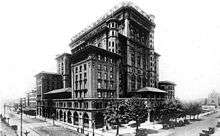Hotel Vancouver (1916)

The Hotel Vancouver, the second of three by that name, was a 15 story (77m) Italian Renaissance style hotel built in 1916 by the Canadian Pacific Railway. The architect was Francis S. Swales.
The hotel passed onto the Canadian National Railway, which demolished the building in 1949. The third Hotel Vancouver, built in 1937 two blocks away, is still operating today.
Famous Guests
Many famous people stayed at this hotel, including Winston Churchill, Sarah Bernhardt, Babe Ruth, Ethel Barrymore, and Anna Pavlova. It was also much loved by the people of Vancouver, who made its rooftop dining room and dance floor, the Panorama Roof, a favourite place for a night out.
Structure and Location
The structure was one of the triumvirate of large, ornate buildings which anchored the centre of town at Georgia and Granville streets: the Hudson Bay Store, Birks Building, and Hotel Vancouver. Only the Hudson Bay store remains of those three jewels of the city's golden age of Edwardian architecture. Also attached to the hotel and built by the CPR was the Vancouver Opera House, later an Orpheum theatre, the city's first. It had become the Lyric Theatre by the time it was demolished to make way for the construction of Pacific Centre.
The site is one of the highest points in the downtown peninsula, good for an imposing building, a fact not lost on the Canadian Pacific . The upstart Canadian Northern wanted to impress the town to further its rivalry with the Canadian Pacific. To this end, the east side of False Creek was filled in to expand rail yards and situate a Beaux Arts CN station. Once flanked by a much more elaborate Great Northern station, since demolished, the Pacific Central Station still stands today. Fearing the market was not large enough for competing hotels, the city and both railways agreed to a joint CP-CN hotel as a condition for commencing the work.
However, the bankruptcy of the Canadian Northern Railway, the First World War, the Great Depression, and a more than suitable existing hotel, delayed the building of the third Hotel Vancouver until 1937. When it was erected, it was expedited as a public work project to bring in much needed construction in the dark days of the Depression.
World War II
During the Second World War, the second Hotel Vancouver was used as a barracks. The building was boarded up and placed under guard at the end of the war, a time when returning veterans were having difficulty finding housing. In January 1946 thirty-five veterans, unimpeded by Army sentries, took over the vacant hotel and announced the building was now veterans housing. They organized themselves and soon were housing approximately 1,000 veterans and some spouses.
The building was used by the veterans until 1948 and torn down a year later. The block became a parking lot until 1969. The Pacific Centre, including the TD Tower and the main Vancouver Eaton's Store (now Nordstrom), was constructed between 1969 and 1972 and stands on the site today.
Media depictions
The hotel was recreated in virtual form in the 2014 interactive work Circa 1948.[1][2]
References
- ↑ Ahearn, Victoria (23 April 2014). "NFB's Circa 1948 project at Tribeca Film Festival". Toronto Star. The Canadian Press. Retrieved 23 April 2014.
- ↑ Farago, Jason (22 April 2014). "Stan Douglas' Circa 1948: 'It's not a game, it's a story'". The Guardian. Retrieved 23 April 2014.
External links
- Emporis Listing
- BC Archives Photo: Second Hotel Vancouver, Georgia & Granville, c.1920
- BC Archives Photo: Billiard Room, Second Hotel Vancouver, 1920s
- BC Archives Photo: Dining Room, Second Hotel Vancouver, 1920s
- BC Archives Photo: Interior, Second Hotel Vancouver, 1916